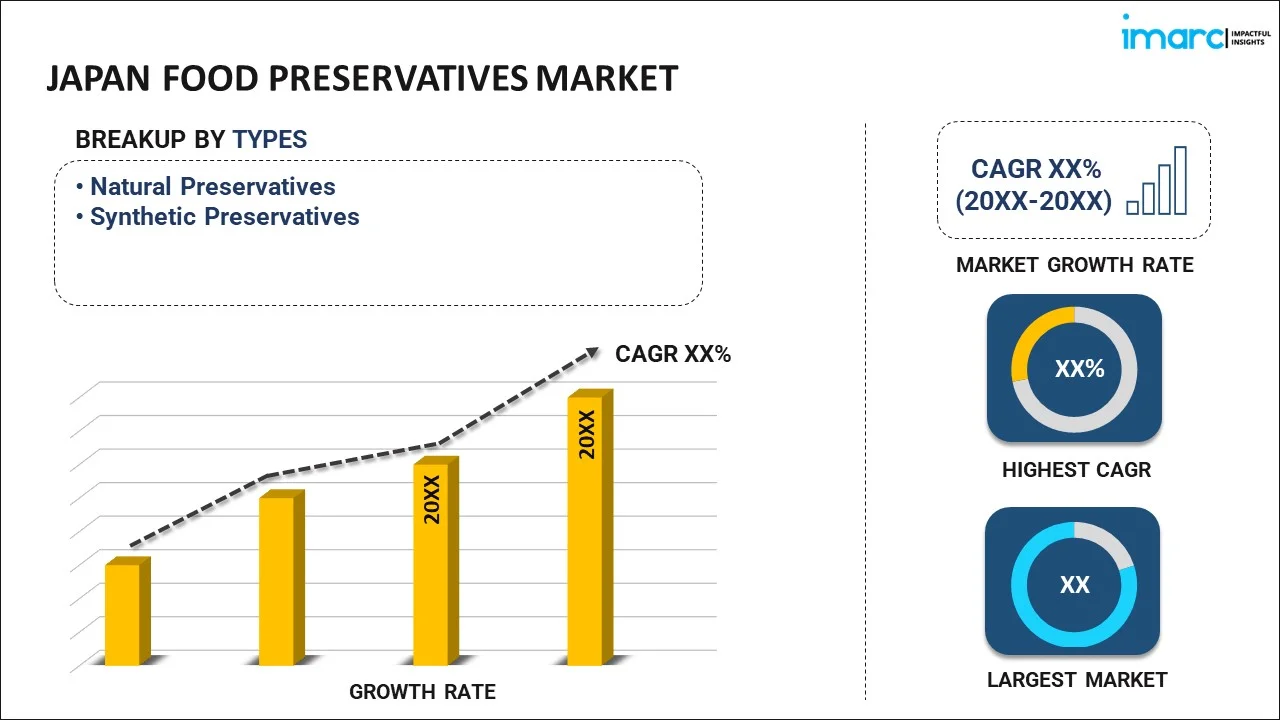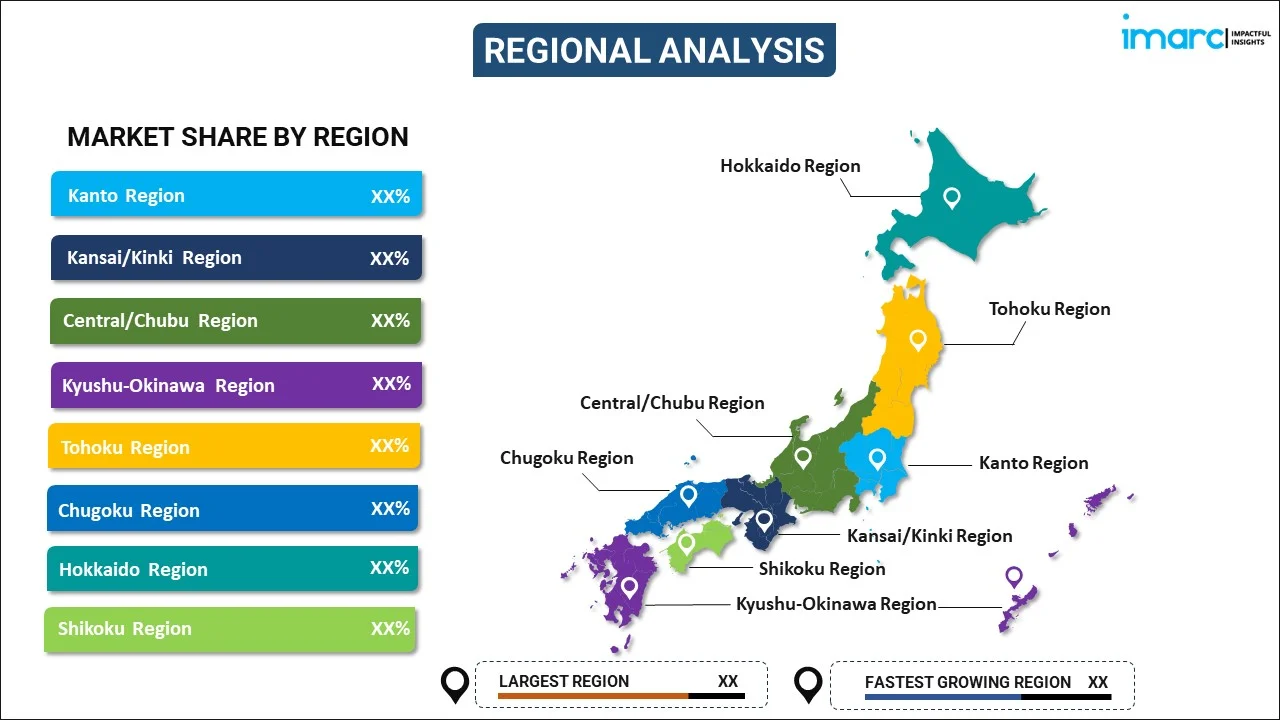
Japan Food Preservatives Market Report by Type (Natural Preservatives, Synthetic Preservatives), Application (Beverages, Dairy and Frozen Products, Bakery, Meat, Poultry, and Seafood, Confectionery, Sauces and Salad Mixes, and Others), and Region 2026-2034
Market Overview:
Japan food preservatives market size reached USD 149.4 Million in 2025. Looking forward, IMARC Group expects the market to reach USD 219.3 Million by 2034, exhibiting a growth rate (CAGR) of 4.36% during 2026-2034. The increasing demand for packaged and processed foods that require preservative solutions to extend product shelf life as well as preserve taste, nutrient, flavor, and texture, is mainly driving the market.
|
Report Attribute
|
Key Statistics
|
|---|---|
|
Base Year
|
2025
|
|
Forecast Years
|
2026-2034
|
|
Historical Years
|
2020-2025
|
| Market Size in 2025 | USD 149.4 Million |
| Market Forecast in 2034 | USD 219.3 Million |
| Market Growth Rate 2026-2034 | 4.36% |
Food preservatives are additives used in food items to extend their shelf life by preventing the growth of microorganisms and inhibiting oxidation. This category encompasses a range of substances, such as salt, vinegar, rosemary extract, sorbates, and benzoates. Food preservatives have wide-ranging applications across the food industry, including canned goods, dairy items, baked goods, processed meats, beverages, as well as fruits and vegetables, among others. Their primary function is to enhance food safety by thwarting spoilage, retaining nutritional value, and improving taste. Furthermore, food preservatives play a pivotal role in reducing food waste by prolonging the period during which food products remain suitable for consumption, and they also contribute to streamlining the distribution of various food items. In essence, these additives are indispensable tools in ensuring that the food supply remains safe, nutritious, flavorful, and efficient in meeting the demands of a regional food market.
Japan Food Preservatives Market Trends:
The food preservatives market in Japan is experiencing growth, spurred by extensive product use to diminish food waste and encourage sustainability. In addition to this, the surge in online grocery shopping is also driving growth, necessitating products capable of enduring extended delivery periods. Moreover, the increasing financial capacity of consumers, enabling purchases of superior preserved foods, is also bolstering the regional market. There is also a growing inclination towards natural preservatives like ascorbic acid and tocopherol, aligning with the prevalent trend of healthy eating, which positively impacts the market. Additionally, the enactment of beneficial government policies, since they compel manufacturers to incorporate approved preservatives in their reformulations, is also creating a positive outlook for the market. Apart from this, the emerging popularity of preservation technologies, such as controlled release and nanotechnology, which are effective, environmentally sustainable, and health-conscious, is expected to drive the food preservatives market in Japan during the forecast period.
Japan Food Preservatives Market Segmentation:
IMARC Group provides an analysis of the key trends in each segment of the market, along with forecasts at the country level for 2026-2034. Our report has categorized the market based on type and application.
Type Insights:

- Natural Preservatives
- Synthetic Preservatives
The report has provided a detailed breakup and analysis of the market based on the type. This includes natural preservatives and synthetic preservatives.
Application Insights:
- Beverages
- Dairy and Frozen Products
- Bakery
- Meat, Poultry, and Seafood
- Confectionery
- Sauces and Salad Mixes
- Others
A detailed breakup and analysis of the market based on the application have also been provided in the report. This includes beverages, dairy and frozen products, bakery, meat, poultry, and seafood, confectionery, sauces and salad mixes, and others.
Regional Insights:

- Kanto Region
- Kansai/Kinki Region
- Central/ Chubu Region
- Kyushu-Okinawa Region
- Tohoku Region
- Chugoku Region
- Hokkaido Region
- Shikoku Region
The report has also provided a comprehensive analysis of all the major regional markets, which include Kanto Region, Kansai/Kinki Region, Central/ Chubu Region, Kyushu-Okinawa Region, Tohoku Region, Chugoku Region, Hokkaido Region, and Shikoku Region.
Competitive Landscape:
The market research report has also provided a comprehensive analysis of the competitive landscape. Competitive analysis such as market structure, key player positioning, top winning strategies, competitive dashboard, and company evaluation quadrant has been covered in the report. Also, detailed profiles of all major companies have been provided.
Japan Food Preservatives Market Report Coverage:
| Report Features | Details |
|---|---|
| Base Year of the Analysis | 2025 |
| Historical Period | 2020-2025 |
| Forecast Period | 2026-2034 |
| Units | Million USD |
| Scope of the Report | Exploration of Historical and Forecast Trends, Industry Catalysts and Challenges, Segment-Wise Historical and Predictive Market Assessment:
|
| Types Covered | Natural Preservatives, Synthetic Preservatives |
| Applications Covered | Beverages, Dairy and Frozen Products, Bakery, Meat, Poultry, and Seafood, Confectionery, Sauces and Salad Mixes, Others |
| Regions Covered | Kanto Region, Kansai/Kinki Region, Central/ Chubu Region, Kyushu-Okinawa Region, Tohoku Region, Chugoku Region, Hokkaido Region, Shikoku Region |
| Customization Scope | 10% Free Customization |
| Post-Sale Analyst Support | 10-12 Weeks |
| Delivery Format | PDF and Excel through Email (We can also provide the editable version of the report in PPT/Word format on special request) |
Key Questions Answered in This Report:
- How has the Japan food preservatives market performed so far and how will it perform in the coming years?
- What has been the impact of COVID-19 on the Japan food preservatives market?
- What is the breakup of the Japan food preservatives market on the basis of type?
- What is the breakup of the Japan food preservatives market on the basis of application?
- What are the various stages in the value chain of the Japan food preservatives market?
- What are the key driving factors and challenges in the Japan food preservatives?
- What is the structure of the Japan food preservatives market and who are the key players?
- What is the degree of competition in the Japan food preservatives market?
Key Benefits for Stakeholders:
- IMARC’s industry report offers a comprehensive quantitative analysis of various market segments, historical and current market trends, market forecasts, and dynamics of the Japan food preservatives market from 2020-2034.
- The research report provides the latest information on the market drivers, challenges, and opportunities in the Japan food preservatives market.
- Porter's five forces analysis assist stakeholders in assessing the impact of new entrants, competitive rivalry, supplier power, buyer power, and the threat of substitution. It helps stakeholders to analyze the level of competition within the Japan food preservatives industry and its attractiveness.
- Competitive landscape allows stakeholders to understand their competitive environment and provides an insight into the current positions of key players in the market.
Need more help?
- Speak to our experienced analysts for insights on the current market scenarios.
- Include additional segments and countries to customize the report as per your requirement.
- Gain an unparalleled competitive advantage in your domain by understanding how to utilize the report and positively impacting your operations and revenue.
- For further assistance, please connect with our analysts.
 Request Customization
Request Customization
 Speak to an Analyst
Speak to an Analyst
 Request Brochure
Request Brochure
 Inquire Before Buying
Inquire Before Buying




.webp)




.webp)












